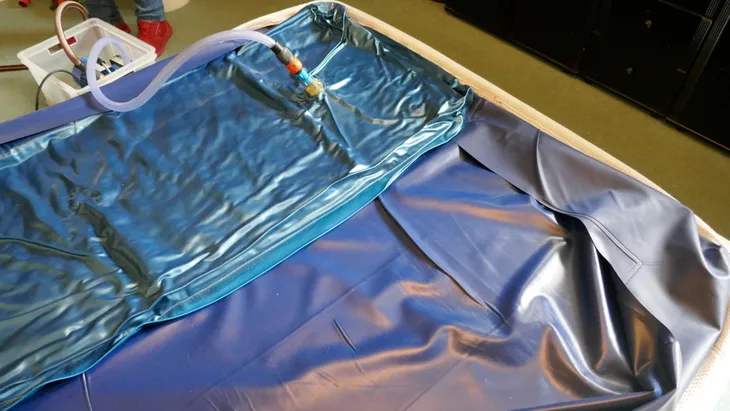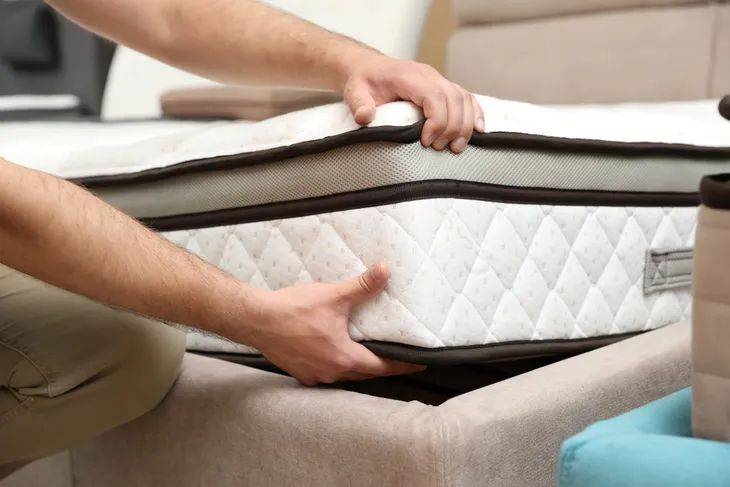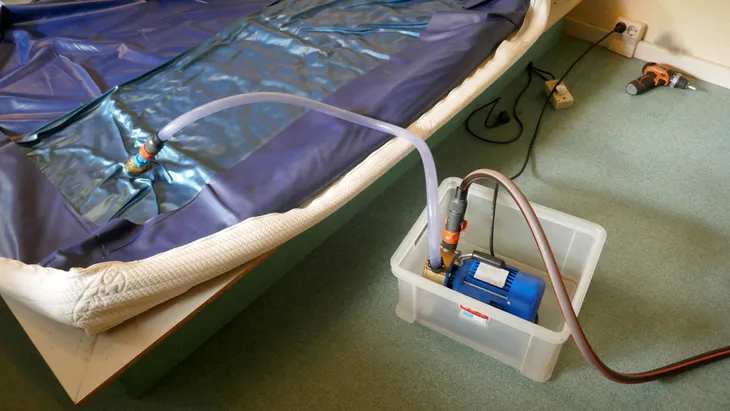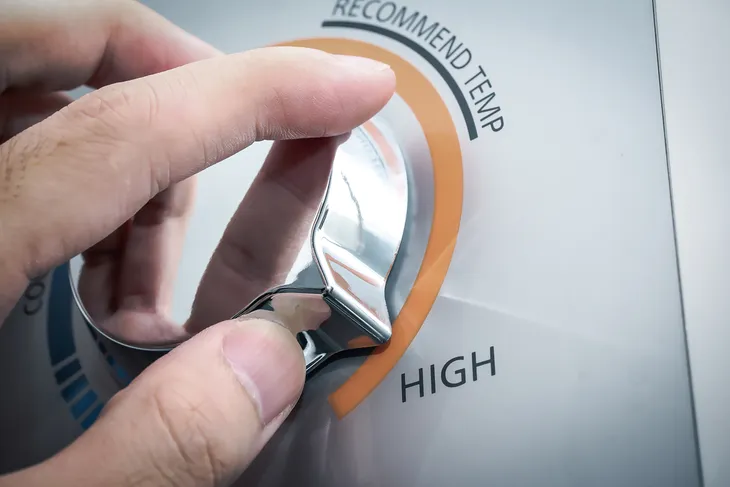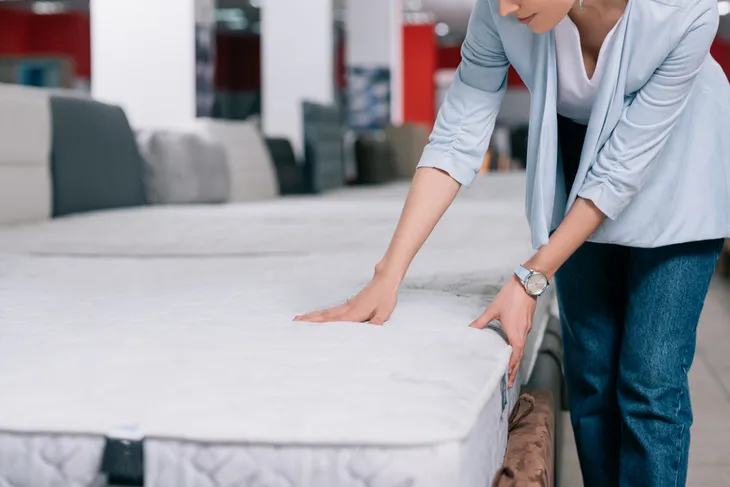- Waterbeds are mattresses that are filled with water.
- While they were more popular in the 70s and 80s, they’re still available and an option worth considering.
- Waterbeds can be a costly investment so it’s important to weigh the pros and cons of owning one.
A waterbed is exactly as it sounds. It’s a mattress filled with water instead of foam or springs. The mattress contains a bladder that is filled with water, which is either a group of small tubes or one large bag. Waterbeds may not be as popular as they once were in the 70s and 80s but they are still available and an option you should consider when mattress shopping.
If you’re on the hunt for a new mattress or have always been curious if waterbeds are worth the investment then follow along as we take a look at the different types of waterbeds plus the pros and cons of owning one.
Types of Waterbeds
There are two main types of waterbeds: a hardside waterbed and a softside waterbed. Hardside waterbeds are the traditional style that many people are familiar with. These beds consist of a wooden external frame that you put the vinyl bladder into. One positive to this is they come with a head and footboard so you don’t have to purchase an additional frame for it.
One downfall to this style is that they often come in unique sizes. Standard-size bedding won’t fit. You’ll have to purchase special waterbed sheets, a comforter, and padding.
Softside Waterbeds
Softside waterbeds are more modern. They look like a traditional mattress but they offer similar benefits to a hardside waterbed. Some consumers claim you gain more benefits from a hardside waterbed as there are fewer layers in between you and the water while others like the softside models better because they have additional layers of padding and quilting. Some consumers find that this type provides more support.
Another benefit to softside waterbeds is that they’re a lot easier to get on and off of compared to the hardside waterbed. And, this type comes in conventional sizes, meaning you’ll be able to purchase standard sheets and bedding. But ultimately, you’ll have to go to a showroom and test out the two styles for yourself to find out which you like better.
Now that you know which types of waterbeds are available, let’s take a look at the pros and cons of owning a waterbed!
Pro: Can Be Very Comfortable
One major benefit of a waterbed is that some people say they’re very comfortable. A waterbed molds to your body, meaning the pressure is evenly displaced. Not only can this be comfortable but it may benefit your spine. Additionally, waterbeds require a heater and the warmth from the bed can add to the comfortability.
Finally, some waterbeds have a wave option, which creates a small wave effect. This can provide similar benefits to a massage. But waterbeds are certainly a personal preference so you’ll need to test one out for yourself to see if you like it.
Con: Installation Can Be a Pain
Setting up a hardside and a softside waterbed can be a challenge and is often one of the biggest drawbacks for consumers. You have to fill the bladder with water which can be a pain and expensive, especially if you pay for water.
In fact, a king waterbed can hold around 235-gallons (1068-liters) of water. Just for comparison, the standard bathtub holds about 42-gallons (158-liters) of water. Not to mention, you’ll have to figure out how to get the water in your bedroom, and hauling a garden hose isn’t always ideal.
Con: Waterbeds Require Maintenance
In addition to the initial installation, your waterbed will require maintenance. This can be another drawback for consumers.
For starters, you’ll have to add waterbed conditioner to the water at least once a year. This helps keep the vinyl free of bacteria and conditions the interior of the vinyl keeping it supple. Without it, over time the vinyl will be prone to cracking
You’ll also need to be on the lookout for leaks. While they’re less common with modern waterbeds, it’s still possible. If a leak occurs you’ll need to use a vinyl repair patch to fix the hole.
Pro: May Benefit Arthritis
Arthritis causes inflammation or swelling of the joints. And while this can be painful on its own, the Arthritis Foundation says that 80-percent of arthritis sufferers have difficulty sleeping. All the more reason to invest in good sleep hygiene. And it turns out waterbeds may benefit arthritis.
Waterbeds can benefit individuals with arthritis because these types of mattresses provide all-0ver-support and reduce pressure and pain in the joints. The hips and shoulders are also level with the spine, allowing your body to be in a natural position. Additionally, if your waterbed has a heater, the warmth can help improve blood circulation which can also help reduce joint pain.
Con: They Require a Water Heater
The water in a waterbed needs to be heated with a water heater. Without one, the bed would be very cold, and sleeping on a cold waterbed can reduce body heat faster than cold air. You also won’t be able to reap the benefits of a waterbed if it’s cold and it may increase your risk of pain and soreness.
Modern waterbeds often come equipped with a water heater but it is still possible to find one without it, especially if it’s a low-range waterbed. This simply means you’ll need to purchase one, which can be a con for some consumers. Once your bed is set up you’ll want to keep an eye on the water heater from time to time to make sure it’s heating your bed correctly. The ideal temperature is around 85- to 92-degrees Fahrenheit.
Pro: May Last Longer Than Other Mattresses
When taken care of, a waterbed can last a long time. In fact, Helix Sleep notes that waterbeds can last upwards of 20-years, whereas standard foam mattresses only last 8- to 10-years. The source also notes that some waterbeds come with an extensive warranty too.
While this is certainly a benefit, how long your waterbed lasts all depends on how well you take care of it. To ensure your waterbed lasts, you need to make sure it’s properly installed and maintained throughout the years.
Con: Waterbeds Are Very Heavy
Another potential con is that waterbeds are incredibly heavy. This also means they can be hard to move so you don’t want to be rearranging your room every month. In fact, waterbeds can weigh anywhere from 1300-pounds up to 1,850-pounds, depending on the size of the bed. If you do choose to rearrange your room, you’ll need to drain the water from the bladder before moving it.
While most modern homes can accommodate the weight of a waterbed, it’s best to have a building inspector check the structure of your home. This way you’ll know for sure that it can handle the weight.
It’s also worth noting, due to the weight and potential risk of accidental leakage, landlords and building managers often don’t allow waterbeds in rental units. So, be sure to check with your landlord or building manager to find out if it’s allowed before setting it up.
Pro: Waterbeds Are Hypoallergenic
Waterbeds may be a great option for allergy sufferers because they’re hypoallergenic. Since the mattress is mostly made from vinyl, they don’t have the same fibers as traditional mattresses that can trap pollen and dust mites. But that doesn’t mean you can get away with never cleaning the waterbed.
It’s important to regularly clean the exterior of the mattress, ideally once a month. Be sure to use a vinyl-safe cleaner to ensure you don’t dry out the mattress.
Con: May Cause Motion Sickness
Some sources claim that waterbeds won’t cause motion sickness, while others say it is possible. Either way, if you’re prone to motion sickness you may want to err on the side of caution. Or at the very least, see if you can do a trial run before investing in the bed.
Hardside waterbeds may be more likely to cause motion sickness because they’re full motion waterbeds. While the motion stops after you stop moving, every time you readjust your sleeping position the mattresses will start moving again. The good news is most softside waterbeds have foam and layers that help dampen movement.
Pro: The Price Is Comparable to Standard Mattresses
Another pro is the price. Waterbeds are comparable to standard mattresses as they can range anywhere from $75 to $3000. This is a huge price range but it all depends on the size of the bed as well as the features and benefits that come with it.
Like standard mattresses, the price is typically a reflection of the quality of the product. Purchasing a low-end waterbed usually means it doesn’t come with much, including a water heater. But the top-end models often come with waveless technology and comfortable foam. If you’re thinking about buying a waterbed it’s important to shop around.
Con: Waterbeds Can Be Smelly
Another potential con to waterbeds is they can give off a not-so-pleasant odor, especially if you don’t take care of it. First, we should point out that a new waterbed may have a strong vinyl smell, which isn’t pleasant. That said, this odor should dissipate within 24- to 48-hours.
The other problem area is the water inside the bladder of the mattress. It can be a breeding ground for bacteria which may lead to unpleasant odors. If you don’t treat the water the smell may permeate the vinyl and then the sheets. Luckily this can be prevented by treating the water with a water conditioner. You can also try cleaning the exterior of the mattress with baking soda and water as baking soda is a great product that absorbs odors.

